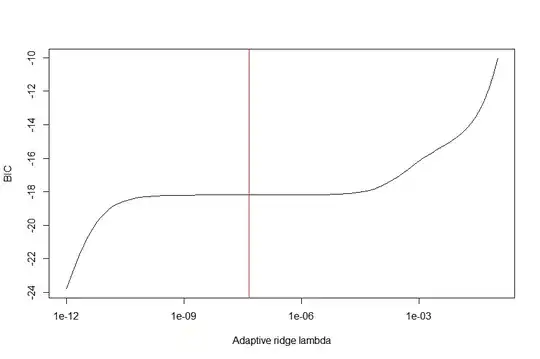For the ridge package you could easily calculate either AIC or BIC or adjusted R2 as measures of goodness of fit, if one uses in these formulae the correct effective degrees of freedom for ridge regression, which work out as the trace of the hat matrix.
Ridge regression models are in fact fit simply as a regular linear regression but with the covariate matrix row augmented with a matrix with sqrt(lambda) [or sqrt(lambdas) in case of adaptive ridge regression] along the diagonal (and p zeros added to the outcome variable y). So given that ridge regression just comes down to doing a linear regression with an augmented covariate matrix you can keep on using many of the features of regular linear model fits. The original paper that the ridge package is based on is worth reading:
Significance testing in ridge regression for genetic data
Main question is how to tune your lambda regularization parameter. Below I tuned the optimal lambda for ridge or adaptive ridge regression on the same data used to fit the final ridge or adaptive ridge regression model. In practice, it might be safer to split your data in a training and validation set and use the training set to tune lambda and the validation set to do inference. Or in the case of adaptive ridge regression do 3 splits and use 1 to fit your initial linear model, 1 to tune lambda for the adaptive ridge regression (using the coefficients of the 1st split to define your adaptive weights) and the third to do inference using the optimized lambda & the linear model coefficients derived from the other sections of your data. There are many different strategies to tune lambda for ridge and adaptive ridge regresion though, see this talk. Of course ridge regression will tend to preserve collinear variables and select them together, unlike e.g. LASSO or nonnegative least squares. This is something to keep in mind of course.
The coefficients of regular ridge regression are also heavily biased so this will of course also severely affect the p values. This is less the case with adaptive ridge.
library(MASS)
data=longley
data=data.frame(apply(data,2,function(col) scale(col))) # we standardize all columns
# UNPENALIZED REGRESSION MODEL
lmfit = lm(y~.,data)
summary(lmfit)
# Coefficients:
# Estimate Std. Error t value Pr(>|t|)
# (Intercept) 9.769e-16 2.767e-02 0.000 1.0000
# GNP 2.427e+00 9.961e-01 2.437 0.0376 *
# Unemployed 3.159e-01 2.619e-01 1.206 0.2585
# Armed.Forces 7.197e-02 9.966e-02 0.722 0.4885
# Population -1.120e+00 4.343e-01 -2.578 0.0298 *
# Year -6.259e-01 1.299e+00 -0.482 0.6414
# Employed 7.527e-02 4.244e-01 0.177 0.8631
lmcoefs = coef(lmfit)
# RIDGE REGRESSION MODEL
# function to augment covariate matrix with matrix with sqrt(lambda) along diagonal to fit ridge penalized regression
dataaug=function (lambda, data) { p=ncol(data)-1 # nr of covariates; data contains y in first column
data.frame(rbind(as.matrix(data[,-1]),diag(sqrt(lambda),p)),yaugm=c(data$y,rep(0,p))) }
# function to calculate optimal penalization factor lambda of ridge regression on basis of BIC value of regression model
BICval_ridge = function (lambda, data) BIC(lm(yaugm~.,data=dataaug(lambda, data)))
lambda_ridge = optimize(BICval_ridge, interval=c(0,10), data=data)$minimum
lambda_ridge # ridge lambda optimized based on BIC value = 5.575865e-05
ridgefit = lm(yaugm~.,data=dataaug(lambda_ridge, data))
summary(ridgefit)
# Coefficients:
# Estimate Std. Error t value Pr(>|t|)
# (Intercept) -0.000388 0.018316 -0.021 0.98338
# GNP 2.411782 0.769161 3.136 0.00680 **
# Unemployed 0.312543 0.202167 1.546 0.14295
# Armed.Forces 0.071125 0.077050 0.923 0.37057
# Population -1.115754 0.336651 -3.314 0.00472 **
# Year -0.608894 1.002436 -0.607 0.55266
# Employed 0.072204 0.328229 0.220 0.82885
# ADAPTIVE RIDGE REGRESSION MODEL
# function to calculate optimal penalization factor lambda of adaptive ridge regression
# (with gamma=2) on basis of BIC value of regression model
BICval_adridge = function (lambda, data, init.coefs) { dat = dataaug(lambda*(1/(abs(init.coefs)+1E-5)^2), data)
BIC(lm(yaugm~.,data=dat)) }
lamvals = 10^seq(-12,-1,length.out=100)
BICvals = sapply(lamvals,function (lam) BICval_adridge (lam, data, lmcoefs))
firstderivBICvals = function (lambda) splinefun(x=lamvals, y=BICvals)(lambda, deriv=1)
plot(lamvals, BICvals, type="l", ylab="BIC", xlab="Adaptive ridge lambda", log="x")
lambda_adridge = lamvals[which.min(lamvals*firstderivBICvals(lamvals))] # we place optimal lambda at middle flat part of BIC as coefficients are most stable there
lambda_adridge # 4.641589e-08
abline(v=lambda_adridge, col="red")

adridgefit = lm(yaugm~.,data=dataaug(lambda_adridge, data))
summary(adridgefit)
# Coefficients:
# Estimate Std. Error t value Pr(>|t|)
# (Intercept) -1.121e-05 1.828e-02 -0.001 0.99952
# GNP 2.427e+00 7.716e-01 3.146 0.00666 **
# Unemployed 3.159e-01 2.029e-01 1.557 0.14026
# Armed.Forces 7.197e-02 7.719e-02 0.932 0.36590
# Population -1.120e+00 3.364e-01 -3.328 0.00459 **
# Year -6.259e-01 1.006e+00 -0.622 0.54326
# Employed 7.527e-02 3.287e-01 0.229 0.82197
Normally in ridge regression the effective degrees of freedom are defined as the trace of the hat matrix - you'd have to check if the BICs calculated as above use these correct degrees of freedom though, otherwise you'd have to calculate them yourself.
